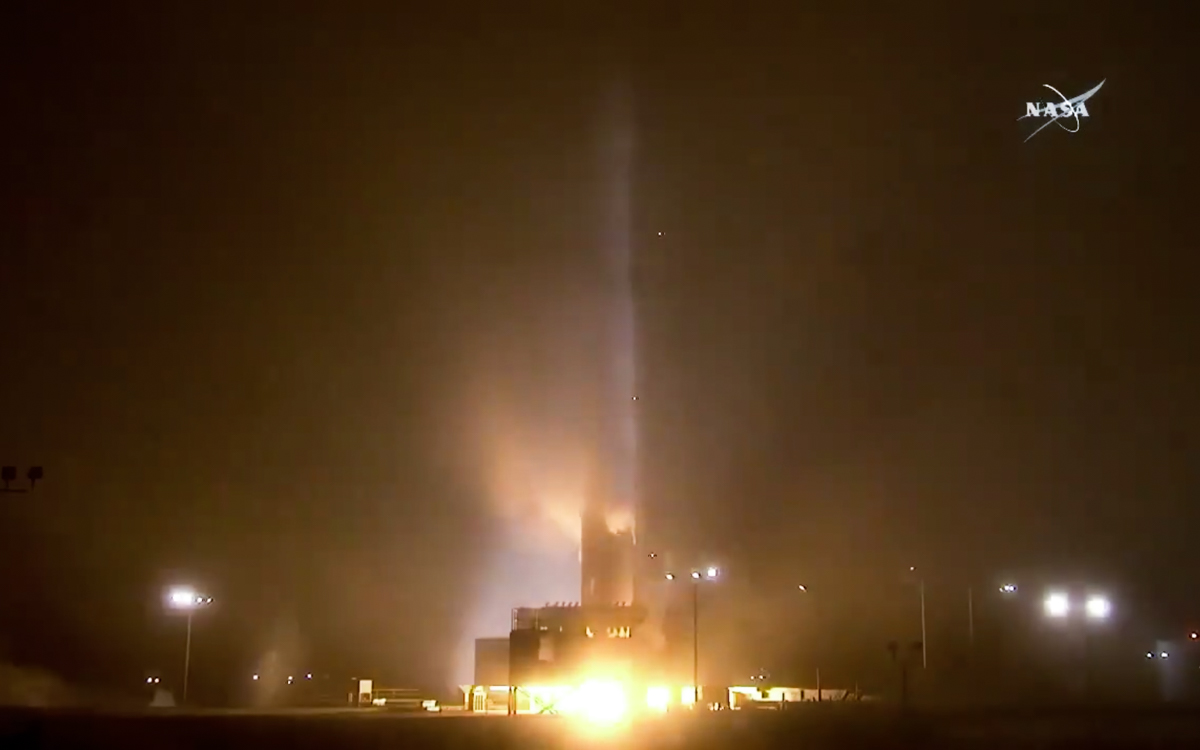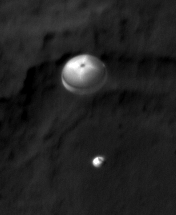
Three weeks from now, on 30 July, the rumble of an Atlas V RD-180 engine and the staccato crackle of four solid-fueled boosters at Space Launch Complex (SLC)-41 at Cape Canaveral Air Force Station, Fla., will herald the start of America’s next voyage to the Red Planet. The Perseverance rover—previously known by the rather drab nomenclature of “Mars 2020”—will deliver a powerful six-wheeled surface vehicle and, for the first time in the history of planetary exploration, also a helicopter, to explore the geologically-rich terrain of Jezero Crater. In our look-back at past U.S. missions to Mars, in Parts 1 and 2 we explored the failures and the successes. In Part 3, AmericaSpace will focus on the five American missions currently there, in orbit and on the ground, and the lessons they have learned about a world we humans might someday call our second planetary home.

Longest-lived among them, and to date the longest active-serving mission to the Red Planet, is Mars Odyssey, which rose from Space Launch Complex (SLC)-17A atop a Delta II booster way back on 7 April 2001. Its very name, “odyssey”, had prompted some consternation, as it was felt that—in spite of the aptness of its launch date—2001: A Space Odyssey writer Arthur C. Clarke might not approve the potential infringement of his copyright. But as circumstances transpired, Clarke was delighted for the new spacecraft to be named after his work and so it came to be that a “real” Martian odyssey got underway in 2001. And it is an odyssey which is expected to endure until 2025.

Upon arrival at the Red Planet six months later after launch, Odyssey brought a powerful array comprising a thermal imager, a gamma-ray spectrometer and an energetic-particle detector known as the Mars Radiation Environment Experiment (MARIE) to assess the presence of current or ancient water-ice and an overall geological and radiation picture. Captured initially into an elliptical orbit, the spacecraft spent three months conducting an extensive “aerobraking” campaign to reduce and circularize its path around the planet. The design of this orbit-shaping architecture not only saved a substantial amount of Odyssey’s station-keeping propellant, but also enabled its launch on the smaller Delta II. By the time the final orbit was attained in February 2002, the spacecraft began a two-year science mission which has been repeatedly extended over the last two decades.

One of its most fundamental discoveries was the detection of large quantities of hydrogen beneath Mars’ surface—a telltale indicator of subsurface ice—and bulk water ice near the equator. And crucially, Odyssey has served as a communications and data-relay satellite for several subsequent U.S. missions, including the two Mars Exploration Rovers (MERs), Spirit and Opportunity, and more recently Curiosity. It has relayed the lion’s share of imagery from those missions back to Earth. It also helped to scour the surface for potential landing sites not only for Curiosity in Gale Crater, but also for Phoenix, which in May 2008 successfully landed in Mars’ north polar region for the first time.

Notwithstanding the early failure of MARIE, which fell foul to a series of devastating solar flares in the fall of 2003, Odyssey has maintained full science functionality ever since. In December 2010, it eclipsed Mars Global Surveyor as the longest-lived operational spacecraft at the Red Planet, which had logged nine years around the planet by the time its own mission ended in 2006. Current expectations, based upon available station-keeping propellant, put the end of the Odyssey mission in about 2025.

Another highly capable spacecraft, the Mars Reconnaissance Orbiter (MRO)—which has drawn the inevitable nickname of “Mr. O”—launched atop a mighty Atlas V from SLC-41 on 12 August 2005, reaching the planet seven months later in March 2006. Over more than a decade of active service, MRO has relayed more data back to Earth than all other Deep Space Network (DSN)-controlled missions combined. In February 2007, it surpassed the record for the maximum quantity of science data ever returned by any spacecraft at Mars and returned enough data in only its first few months to fill 1,000 CD-ROMs.

Always intended as a multi-purpose spacecraft to bridge the gap between surface observations and orbital measurements, MRO can image Martian landscapes at resolutions as fine as 8 inches (20 cm). The spacecraft has contributed enormously to our understanding of the action of water on Mars over millions of years and in August 2012 it captured unique imagery of the dramatic Entry, Descent and Landing (EDL) endured by Curiosity as it plunged toward the surface. It has photographed rovers (and their tire-tracks) on the terrain and even observed the descent of the Phoenix lander towards the Martian arctic in May 2008. One investigator described these accomplishments as “the closest thing you can get to paparazzi on Mars”.

Its instrumentation identified the first direct evidence for the passage or liquid or gas through underground rocks at the Candor Chasma canyon and a series of papers late in 2007 found geologically-recent polar-ice layers and signs of water released by ancient impact events. Surveys of intact bedrock layers pointed to the presence of neutral-to-alkaline water within the last 3.6 billion years and in 2011 MRO identified frozen carbon dioxide at Mars’ south pole—about 30 times more than predicted—which prompted suggestions of significant atmospheric pressure changes, the impaired stability of liquid water and the enhanced severity and frequency of surface dust-storms.
And MRO has aided the discovery of less fortunate missions, considered lost, including the landing site of Russia’s ill-fated Mars 3 spacecraft and in 2015 picking out the location of Britain’s Beagle-2 lander. Fourteen years after launch, MRO is expected to endure until hopefully later this decade.

If Mars Odyssey and MRO have examined the planet in unparalleled depth from on high, then NASA’s Curiosity rover—launched atop an Atlas V from SLC-41 at the Cape on 26 November 2011—has done likewise in terms of gaining “ground truth” data on the surface. Eight months later, in a remarkable “Seven Minutes of Terror” involving not only a supersonic parachute but also the first-of-its-kind use of a rocket-propelled SkyCrane, the 1,980-pound (900 kg) rover landed in the geologically-significant Gale Crater. This 3.5-billion-year-old impact feature is theorized to have been steadily filled with water- and wind-deposited sediments over geological time, after which wind erosion produced the singular peak of Aeolis Mons (“Mount Sharp”) close to its center.
So astonishing were Curiosity’s initial discoveries that within four months of its 6 August 2012 landing on Mars, its mission was extended indefinitely and it continues in a fully functional mode to this very day. Aided by its 17 cameras, the rover has spent almost eight years supporting Mars Exploration Program scientific goals which range from investigating evidence of past or present biological processes on the planet to understanding its geological and geophysical evolution.

To date, it has traveled more than 13.6 miles (21.9 km) from its landing location and, as outlined in a 2018 article by AmericaSpace’s Paul Scott Anderson, has contributed significantly to our comprehension of this strange world.
Two other missions round out NASA’s current inventory of “in-service” machines at the Red Planet. The first, launched via Atlas V from SLC-41 on 18 November 2013, is the Mars Atmosphere and Volatile Evolution (MAVEN) orbiter.

Since its arrival at Mars in September 2014, it has worked extensively to determine how the planet’s substantial atmosphere and water reserves were lost over time to produce the relatively thin gaseous veil that we see today. Notably, MAVEN has revealed that the steady deterioration of the Martian atmosphere tends to intensify during solar storms.

More recently, on 5 May 2018, another Atlas V rocket boosted the Interior Exploration Using Seismic Investigations, Geodesy and Heat Transport (InSight) lander on a mission to touch down on the planet’s Elysium Planitia region. This mission made history as the first U.S. interplanetary voyage to launch from Vandenberg Air Force Base, Calif. Following a 300-million-mile (480 million km) journey across space, InSight landed on Mars the following November and to date—despite suffering a malfunction with its Heat Flow and Physical Properties Package (HP3) heat probe—it has performed well.

Its primary focus is the deployment of a Seismic Experiment for Interior Structure (SEIS) seismometer onto the surface to investigate Mars’ deep interior, although HP3 and its digging “mole” were unable to reach the maximum requisite depth of 16 feet (5 meters). Attempts to work around the problem achieved limited success, although earlier in 2020 the mole has eventually begun to dig deeper into the surface and hope has been rekindled that success is near. In the meantime, InSight has returned eerie, subwoofer-like vibrations to record the “sound” of Mars’ winds and last year researchers announced the detection of as-yet-unexplained magnetic pulses and oscillations.

As outlined at the start of this three-part AmericaSpace feature, the history of exploring Mars has been a mixed bag of spectacular success and depressing disaster, as almost half of all U.S. spacecraft sent there have failed in some capacity in completing their missions; whether in the early stages, during transit or at the planet itself.

With five spacecraft currently in active operational service at Mars, it can be hoped that a 30 July launch of Perseverance will be followed by a trouble-free cruise to Mars and a landing at Jezero Crater next spring. And as with the accomplishments of its predecessors, Perseverance, its Ingenuity helicopter and its advanced suite of life-searching tools and sensors, promise yet another scientific bonanza and greater insight into a world which from the 2030s we humans might come to call our second home.






Je holý nesmysl, “že polovina amerických lodí selhala “, pravda je , že 89% jih excelovalo a pouze jedna selhala.